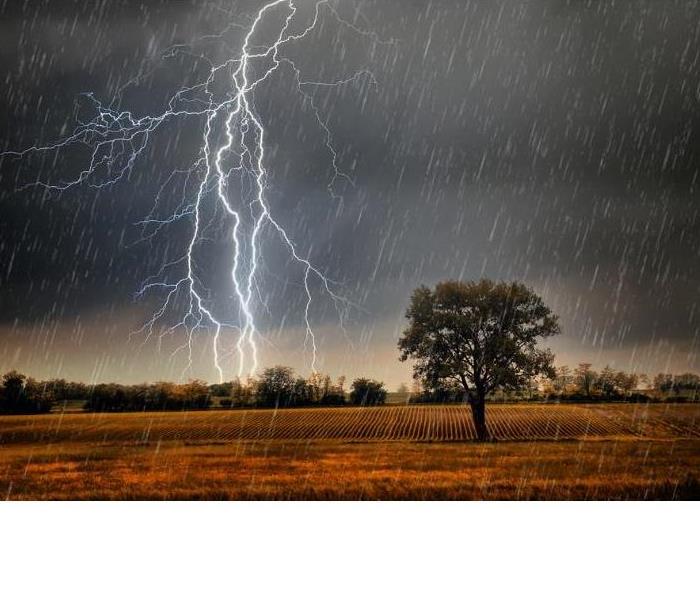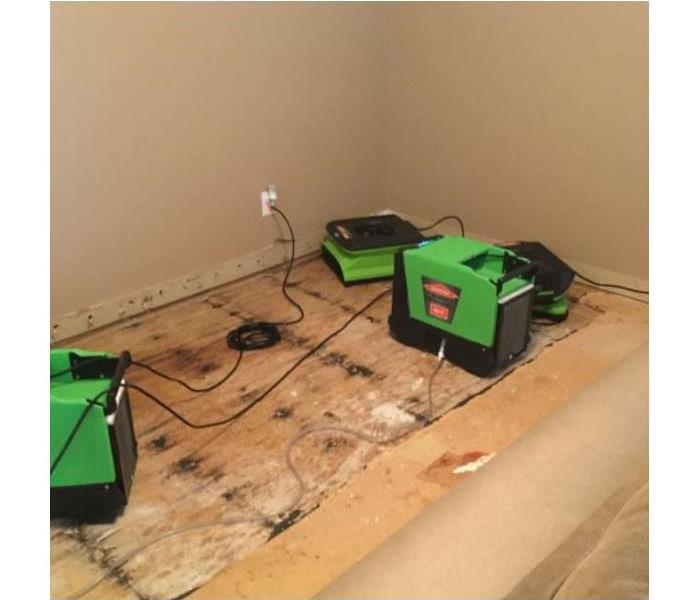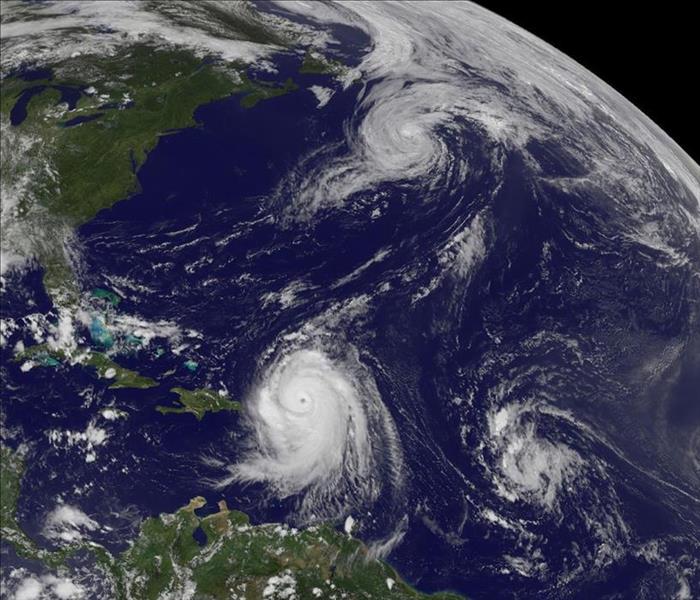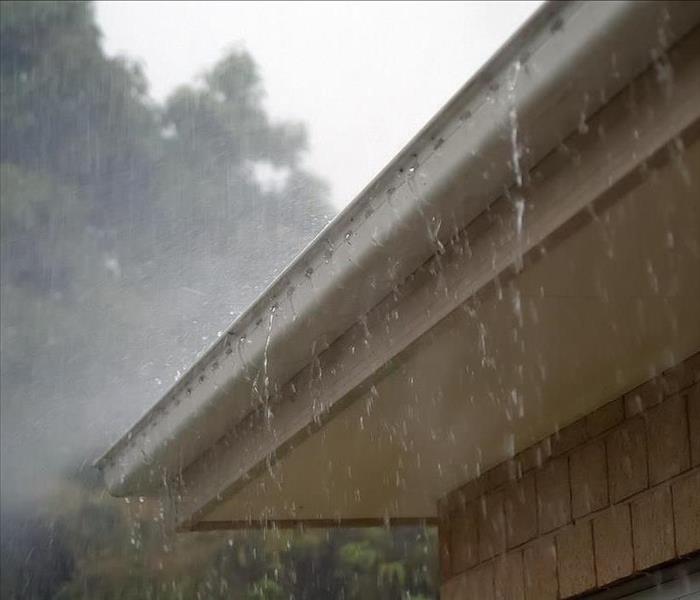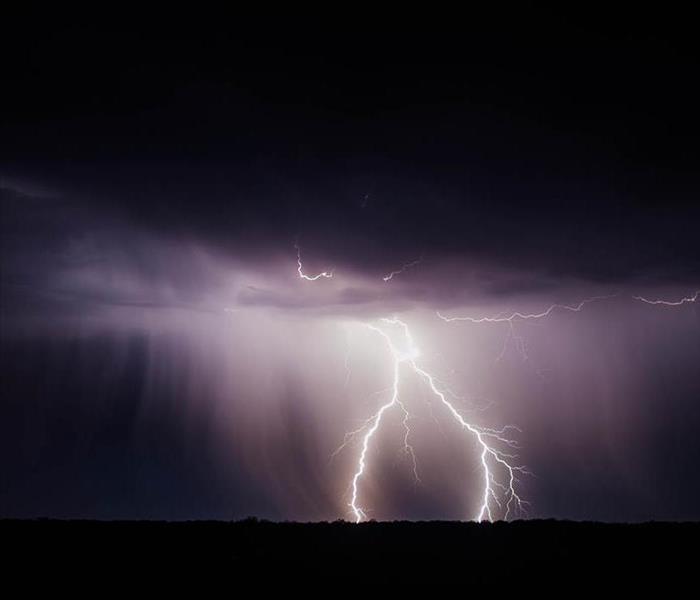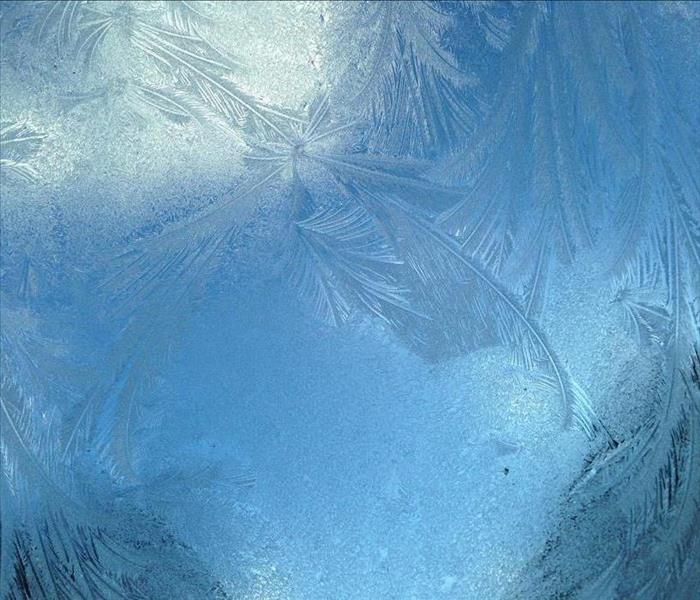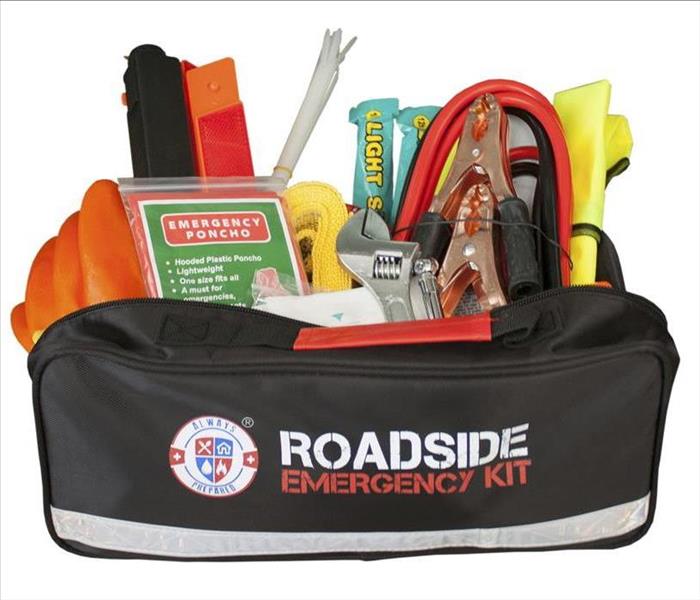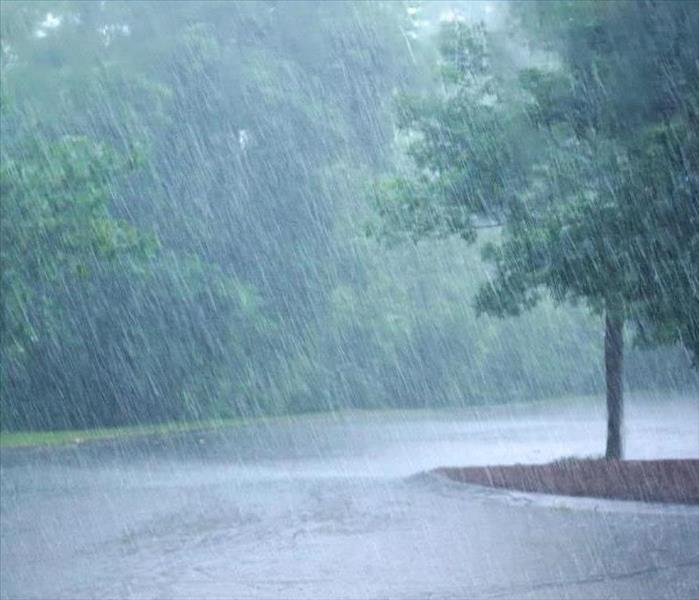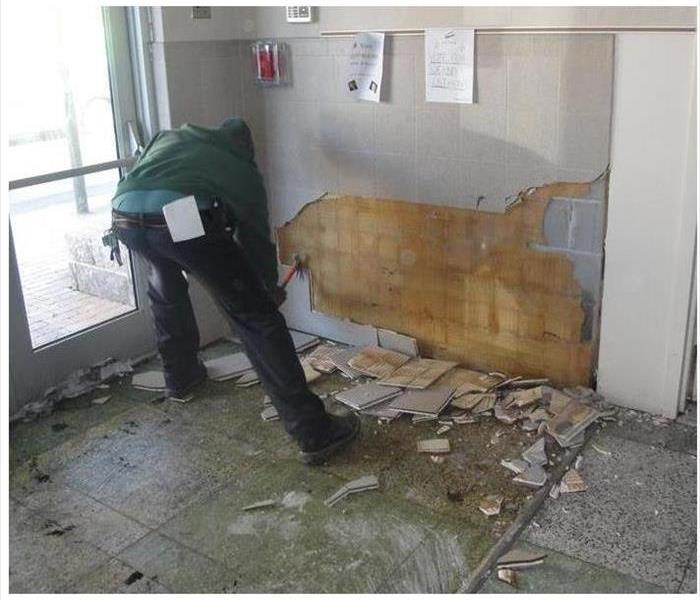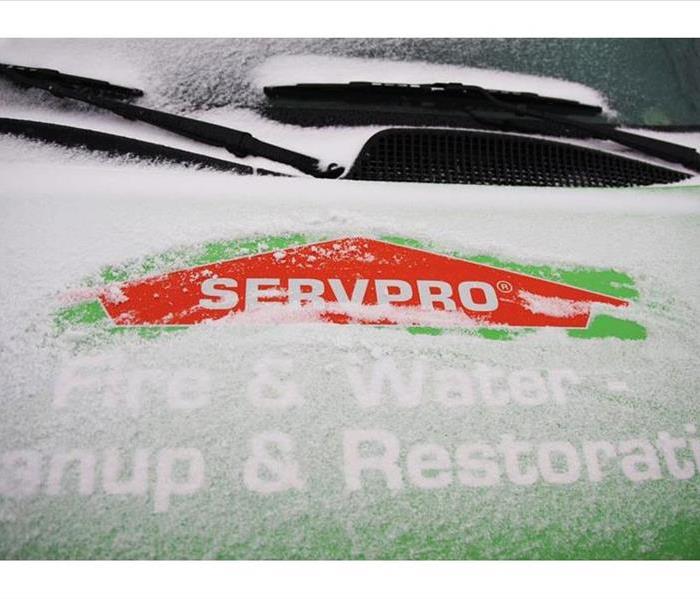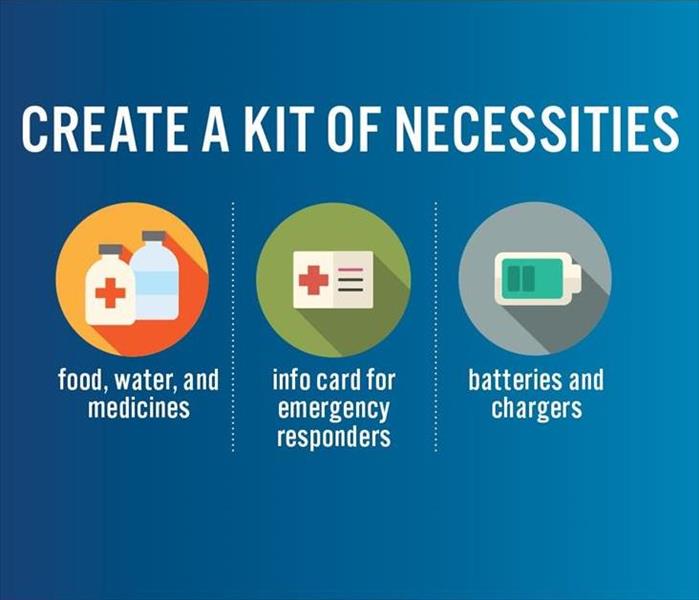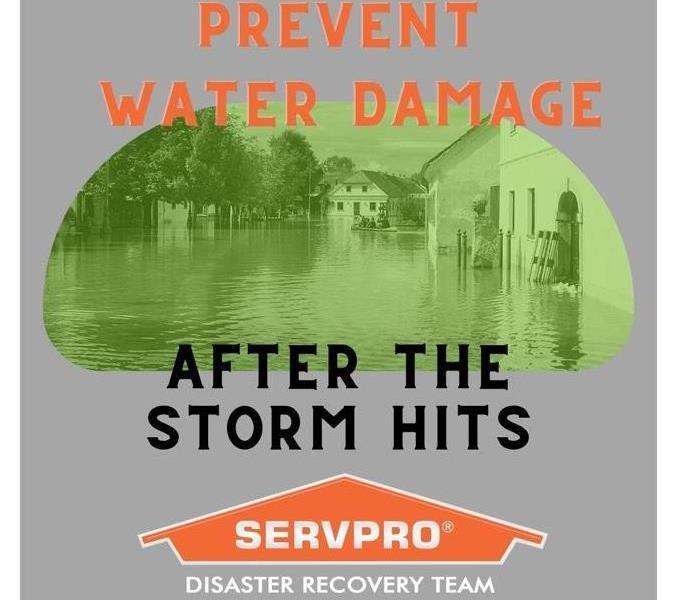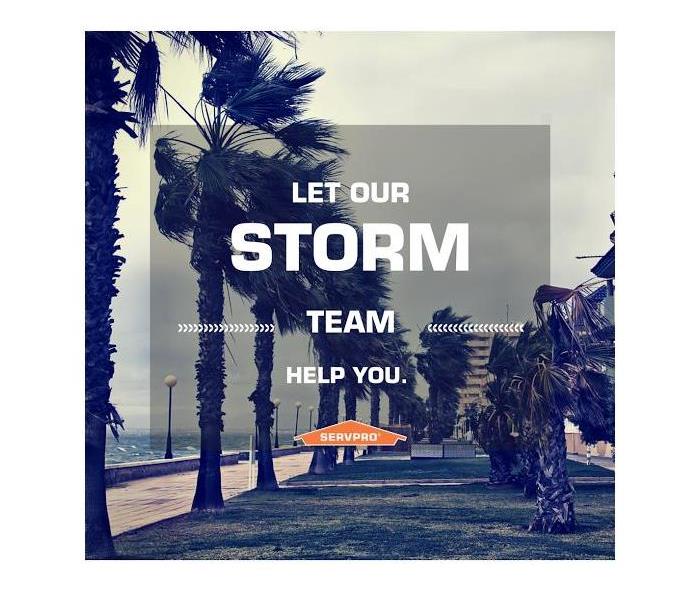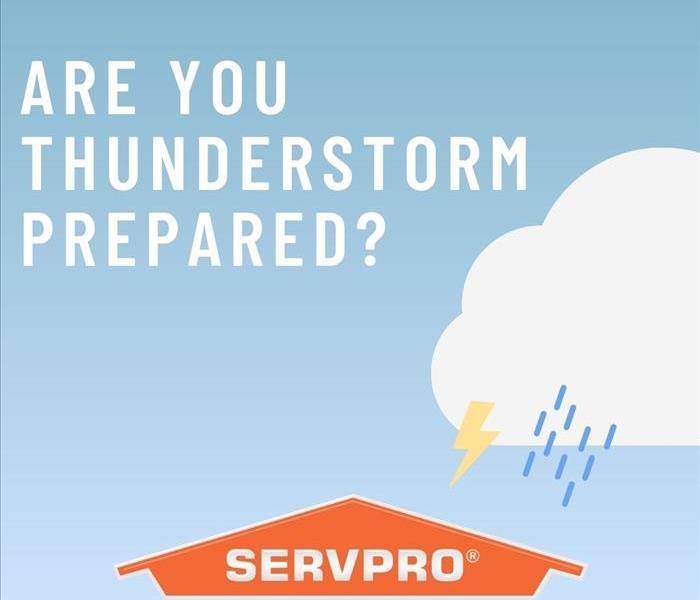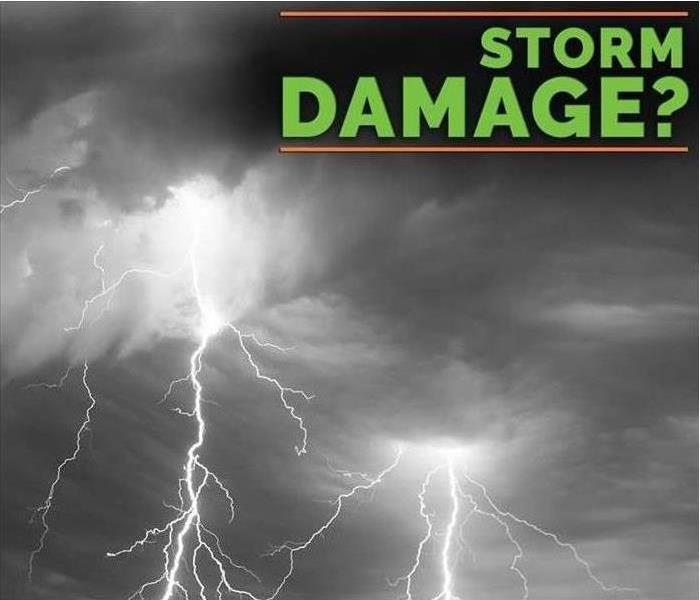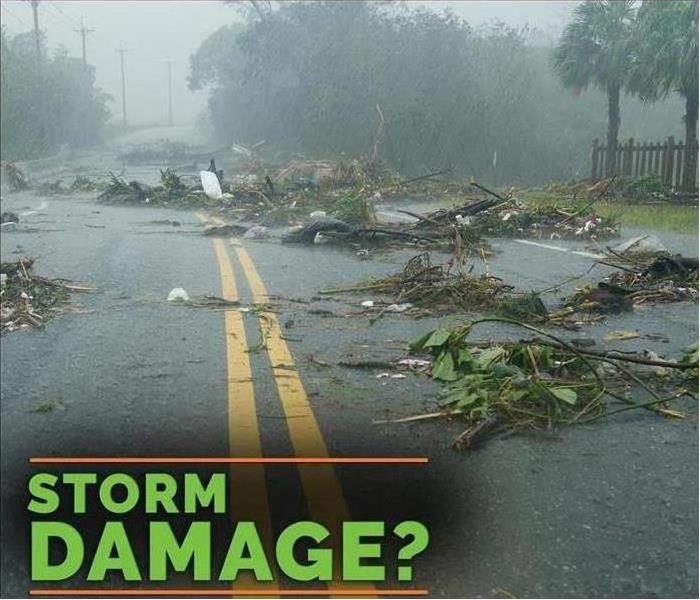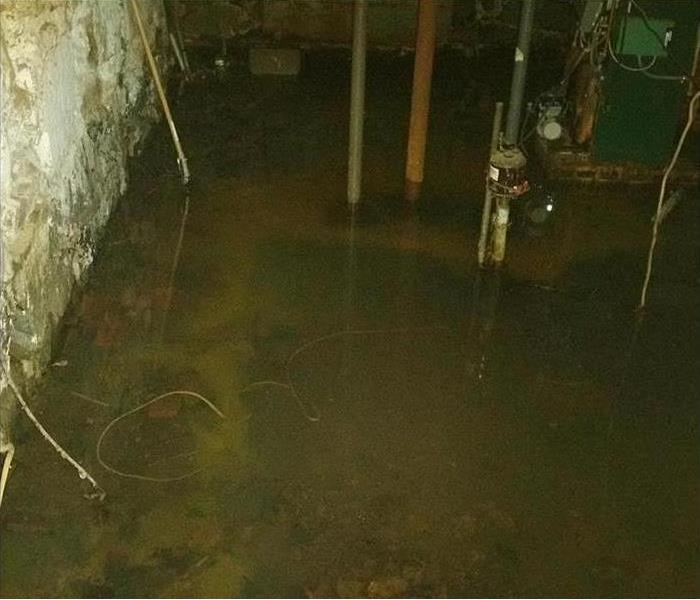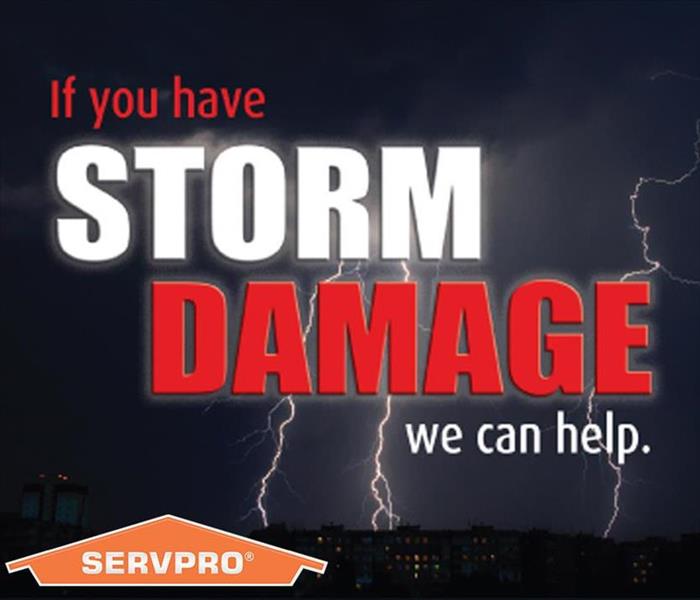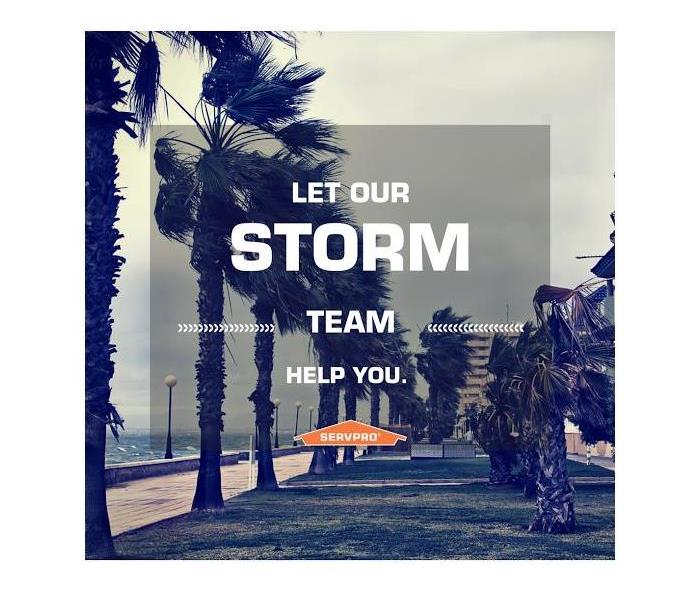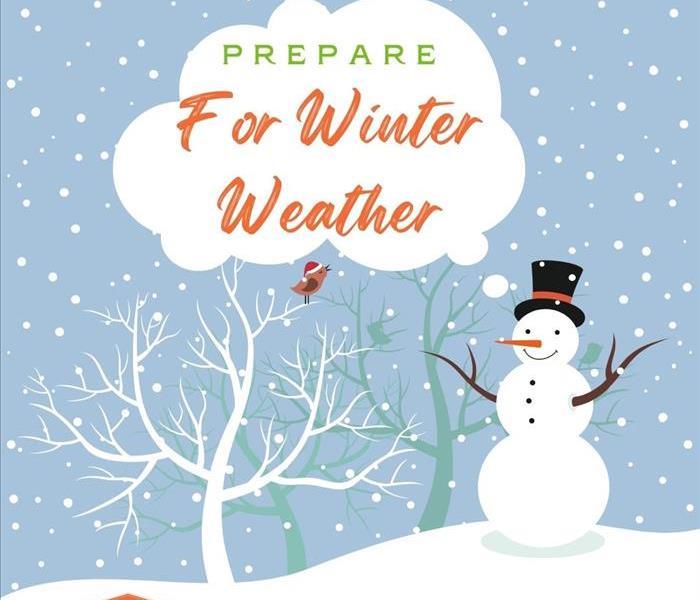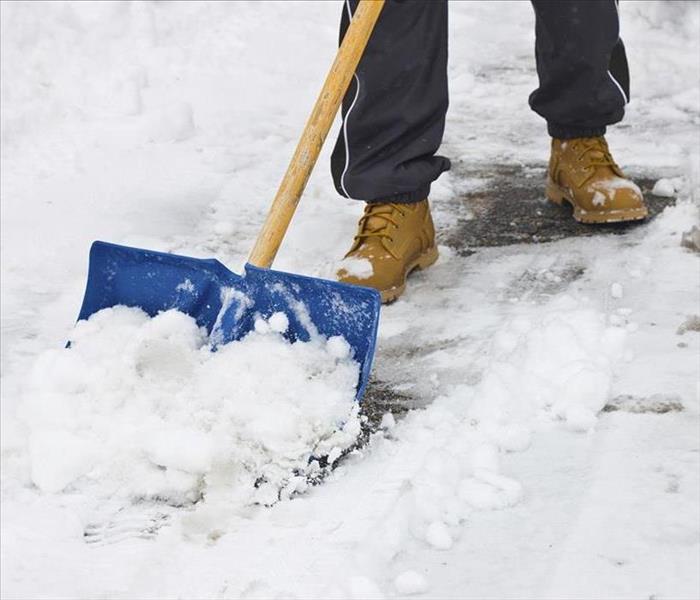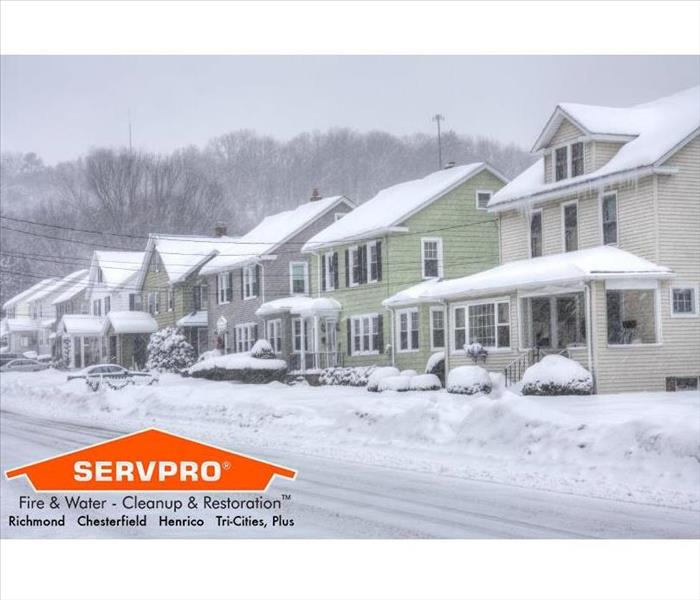Recent Storm Damage Posts
Pet Preparedness for Storm
7/24/2024 (Permalink)
People often talk about making emergency preparedness plans and emergency kits for themselves and their families in the event of severe storms, but how much thought have you given to an emergency plan/kit for your pet? After all they’re part of the family so you’d never leave them behind, but how prepared are you to bring them along?
It’s important when you have pets to make sure that your emergency evacuation plans include places that are pet friendly. Many shelters and hotels do not offer accommodations for animals, so having a safe place to take your pets along with your family is crucial. You should also talk with friends or family to make sure that in the event that you can not evacuate with your pets someone is able to get them and care for them. Finally, you should get your pets microchipped. Keep this info up to date with correct addresses and an emergency contact that is outside of your immediate home. Emergencies can be hectic, and accidents can happen where pets get away from you, but if they are microchipped the likelihood of them being returned home safely is greatly increased.
Once your plan is in place you should build an emergency kit for you pets. Just like for your family’s emergency kit it should include the basic items needed for survival in the event of an emergency:
- Several days’ worth of food and water stored in airtight (waterproof for food) containers
- Medicine/First Aid Kit – talk with your veterinarian to find out what is best for your pets’ personal emergency needs
- Extra collar, ID tag, leash/harness - this should also include copies of your pets’ registrations and other documents in a waterproof container and electronically
- Crates or carriers for each animal
- Grooming items and sanitation needs - emergencies can be messy and having a dirty pet is less than ideal, additionally this should include things like a litter box/litter if appropriate or plastic bags
- A picture of you and your pet together - this can help people to identify your pet should you be separated as well as help prove ownership if needed
- Familiar items – As stressful as emergencies can be for you and your family, they can be even more so for pets who don’t understand what’s going on. Having familiar items like toys or blankets can help make your pet feel safe and more relaxed
Your local SERVPRO knows that during storms being prepared is key and having a plan for everyone involved makes things that much easier. We hope that this little checklist can help you keep your pets safe should any emergencies arrive.
Storm Readiness 101
1/8/2024 (Permalink)
As leaders in the restoration industry, we know firsthand the amount of damage that a storm can do to your home. Addressing the damage as quickly as possible is key to preventing further damage from occurring. We wanted to share some of the most important areas of your home that can be affected by storm damage, so you know where to check afterward.
- Basement – Areas of your home that are underground are some of the spots that are the most prone to water damage following a storm. Check around the edges of your basement floor and walls for signs of moisture. Make sure that drain spouts are properly angled away from your home and that there are no areas where water can pool next to your house.
- Foundation – Similarly to basements, your home’s foundation is particularly threatened by water damage after storms. Water from the outside can seep into cracks in your foundation and weaken it over time. Double-check check there is no standing water or signs of moisture in your concrete, and make sure that your sump pump is functioning properly.
- Crawlspaces – Water can pool in areas underneath your home and cause significant damage to the structural components, like mold and rotting wood.
- Windows – Over time the seals on your windows can degrade and strong storms can crack windows and window frames, allowing water to get into your home.
- Roof – Probably the most prone to storm damage, wind can damage shingles and throw broken tree branches all over your home. As one of the main sources of protection from the outside elements. It is crucial to inspect your roof after a storm. Ensure there are no leaks and remove any debris that could further damage your home. Check for any signs of moisture in your attic as well as this could be a sign that there is a hole somewhere you might’ve missed.
- Gutters – Strong winds and falling branches can damage your gutters or even completely rip them off the side of your house. Your gutters are essential in preventing water from getting into your home and directing it away from your home’s foundation. Make sure that your gutters are in good condition and free from any debris that may clog them.
While storm damage may not always be 100% preventable, hopefully, these tips can help you prevent any further damage from happening, and if you do happen to find any signs of damage to your home after a storm. Our technicians are here to help. We’re available 24/7, 365 days a year, so don’t wait, give us a call and let us know what we can do for you.
Temperatures are dropping, is your home ready?
1/5/2024 (Permalink)
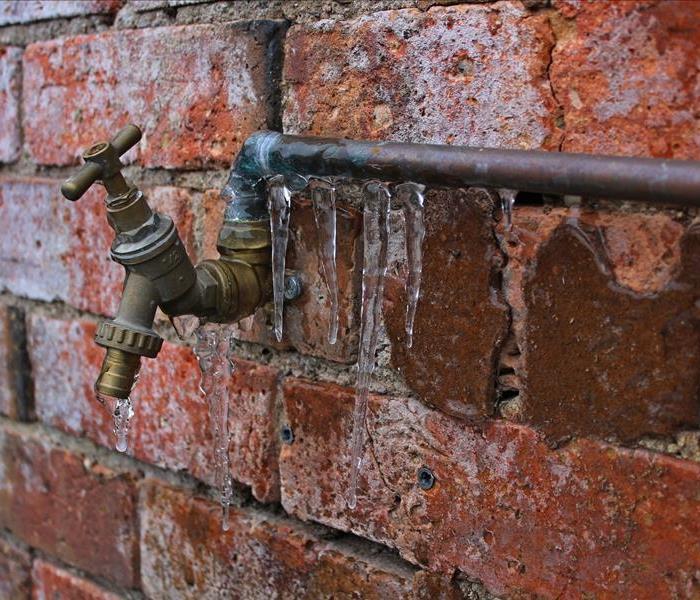
With winter fast approaching and colder weather on the way, is your home ready to keep you and your family dry? Check out these best practices to help prevent winter water damage to your home! • Prevent frozen pipes and pipe bursts o Any faucets connected to pipes in unheated areas (attic, crawl space, outside) are more likely to freeze when the temperature drops. Be sure to let cold water drip from those faucets to help prevent freezing. o If you plan on leaving your home for multiple days during freezing temps leave your heat on. Heating costs may rise a bit, but comparatively, to a burst pipe in your home, you’ll be happy you did. • Prevent ice dams o When warm air from your home heats the roof and melts the snow on the roof it collects in unheated areas and refreezes, making ice dams that limit drainage off the roof and can cause damage to your home. o Make sure to clear your gutters and downspouts so that water can drain off the roof and doesn’t collect anywhere to refreeze o Install gutter screens to help keep out debris build-up in gutters o If you live in an area with especially large amounts of snowfall, consider installing snow guards to prevent snow accumulation on your roof and lining under your shingles to prevent leaks as snow melts • Ensure you know where and how to shut off your water in case of an emergency o When pipes freeze or burst it is important to be able to respond immediately and prevent the issue from getting any worse. Make sure that you know where your water shut-off is and turn it off the second you discover a leak While the cold weather can bring potential damage to your home, taking the proper steps to get ready can help you enjoy the winter wonderland stress-free, and if disaster does happen rest assured that us here at your local SERVPRO are ready to help you make it “Like it never even happened.”
The Importance of Using a Restoration Company
8/11/2022 (Permalink)
When it comes to property damage from a storm, it’s important to stress that it’s likely not something that you should address on your own. There are many factors that go into restoring a building after it’s been damaged by a storm that are often not considered or something that your average person is unable to do themselves. Here are some of the reasons why you should consider a professional restoration company like SERVPRO of Chesterfield and SERVPRO of Tri-Cities, Plus if your building has suffered damage.
- Stopping Continued and Secondary Damage – Unfortunately when it comes to water damage, it’s not over once the rain stops falling. Water will travel anywhere it can and will continue to cause increased damage to your home or business until it is dried. Often water will get behind walls and under cabinets where someone without professional equipment would be able to spot it. Additionally, our team’s equipment will be able to help dry out your home or business faster than you could on your own, helping to reduce repair costs.
- Growth– If water is not properly or quickly cleaned up, it creates a breeding ground for growth to form. Our team uses specialty cleaners and is trained to help ensure that growth won't appear the first time, and won't have the opportunity to spore.
- Equipment – When dealing with flood waters, typical household equipment just doesn’t make the cut. Here at SERVPRO, our teams are constantly training in the latest techniques and in the best equipment to get the job done fast and get it done right. With industrial air movers and dehumidifiers, we’re able to better control the conditions in your home to make the drying process go as smoothly as possible.
Hopefully, this helps you to better understand the need for a professional restoration company in the event of a flood in your home or business. Our teams are available 24/7, 365 days a year for all of your emergency service needs. Please give us a call and let us know how we can make your home or business “Like it never even happened.”
Looking for Hidden Damages After a Flood
7/25/2022 (Permalink)
After a heavy storm, many of the signs that your home has sustained flooding or other water damage are typically pretty obvious, however, there are some places that could have hidden pockets of water that may not be quite as obvious.
Crawl spaces are the area of your home that typically separates the first floor of a home from the ground. It also is typically where you would find the essential structural materials like plumbing and electrical wiring. Because this area is on the ground it is more susceptible to water damage during storms. If not properly dried, this can lead to structural deterioration, mold issues, and damage to your plumbing, wiring, and insulation as well. A professional restoration company like us here at SERVPRO of Chesterfield and SERVPRO of Tri-Cities, Plus will be able to enter your crawlspace and identify any areas of hidden moisture that you might otherwise not be able to see.
Attics are another area often forgotten about after storms. Heavy storms have the potential to damage your roof and allow moisture to enter your attic. Because attics are often not climate controlled like the rest of your house is, they are typically areas of large temperature swings, and higher humidity, so when additional moisture is present and not addressed it can be incredibly problematic. Be sure to check out your attic regularly and inspect for any signs of water damage and moisture buildup, especially after any heavy storms. If you’re ever unsure of an area our team is trained to identify problem areas and have special equipment that helps us spot moisture in hidden spots.
Once any issues have been identified the first step is to remove the damaged materials and begin to dry it out. Our team will place air movers and dehumidifiers to help reduce moisture in the air as well as pull it out of your structural materials. Once it is dry, we can address any issues with damaged components that may need either repaired or in some cases replaced.
Remember that water damage will continue to get worse the longer that it sits on your property so it is imperative to act quickly and address any issues you may have. Please don’t hesitate to call us and let us know how we can help get your home back to “Like it never even happened.”
How Does a Hurricane Form?
7/5/2022 (Permalink)
Anyone who’s experienced one before knows that hurricanes can be one of the most damaging and dangerous storms that you can have in the U.S. While you may already know this, and maybe when to most expect them to occur, how familiar are you with the process of how hurricanes form? Knowing what causes hurricanes can help you to better prepare and keep your family safe during these severe weather events.
Hurricanes and other tropical storms form in the same way. Out in the ocean, near the equator where the water is warm. When the ocean water evaporates this moist air rises, as it goes higher and cools it condenses into water droplets, which is how storm clouds are created. The winds over the Atlantic Ocean are very strong and as they blow across the waters, when combined with these storm clouds, they can begin blowing into a circular pattern. This is the beginnings of a tropical cyclone. These cyclones have four stages of growth ending at a hurricane.
1) Tropical Disturbance – This is characterized by a mass of storm clouds that has begun to pick up circulation and a slight potential for damage. Winds in a tropical disturbance do not exceed 24mph.
2) Tropical Depression – Once wind speeds have reached between 25-39mph a cyclone depression can form. As warm air rises from the storm and cools, this release of heat causes the top level of storm clouds to warm. This increases air pressure and shifts the winds outward from the center of the storm. As the winds move away and the air pressure drops, more warm air from the ocean’s surface rises. As this cycle continues the storm begins to spin faster and increase in wind speed.
3) Tropical Storm – Past 39pmh, this is now considered a tropical storm. The winds are spinning fast enough now that the clouds start to gather into the telltale circular shape we’ve all seen on the weather channel. This is when a storm is given a name. These storms can grow quickly and are definitely a sign that you should begin storm preparations should you find one is forecasted to head your way.
4) Hurricane – Once a tropical storm reaches 74mph wind speeds it is considered a hurricane. These storms are typically around 300 miles wide but can grow vastly larger. The largest to date is Hurricane Sandy which reached as wide as 1,150 miles or about half the length of the east coast.
Now that you know how these hurricanes form, you’ll hopefully be able to better understand how to best keep your family safe during these storms. Our SERVPRO of Chesterfield and SERVPRO of Tri-Cities, Plus is a proud member of the SERVPRO Disaster Recovery Team. With strategic placement all over the United States the SERVPRO Disaster Recovery Team is equipped to help with any size disaster and has participated in the recovery efforts in storms like Hurricane Katrina, Harvey, and Sandy. We’re here to help get you and your family back on track after a natural disaster.
Prepare Your Home for Summer Showers
6/16/2022 (Permalink)
Summer is almost here! The sun is shining, and the temperature is warming up, but this also means that it’s time for the summer rain! It’s important to take some time and make sure that your home is ready for the wet weather and also that the harsh winter hasn’t caused any damage. Here are a few things that you should look out for:
- Gutters – With potentially lots of rain on the horizon, your gutters are one of the main defenses you have at keeping water away from your home. Be sure to clean them out and clear any clogs. The heavy weight of snow and ice could have also caused some damage so you should also check to see if there are any leaks or cracks that need to be fixed. Finally, make sure that your downspout is properly aimed so that water coming from your gutters flows away from the home and doesn’t puddle near it.
- Windows – The winter weather can be brutal on the fixtures of your home. You should check the screens and make sure they aren’t damaged. Additionally, you should make sure there are no signs of leaks in the seals/caulking of your window to help prevent water damage and drafts.
- Roof – Look over your roof for any damaged or missing shingles that need replaced. You should also go into your attic and check for any signs of moisture or leaks.
- Siding – Cold temperatures and ice can cause damage to your siding. Walk around the outside of your house and look for any siding that may be extra worn or cracked and needs to be replaced.
- Foundation – Check the foundation of your home for any cracks that may have formed or gotten worse from the cold. A good rule of thumb is if you can fit a coin into the crack you might want to consider having someone come and inspect it to make sure it doesn't need to be repaired.
While this is no means an exhaustive list it’s a good place to start when making sure your home is ready for summer. Proper home maintenance goes a long way in preventing your house from being damaged by the elements, but sometimes things happen. Should you find your home struck by water damage from a summer rainstorm SERVPRO of Chesterfield and SERVPRO of Tri-Cities, Plus is here to help. Our team of professionals are available to help get your home back to “Like it never even happened.” Give us a call and let us know what we can do for you!
Storms Myths vs. Facts
1/7/2022 (Permalink)
Storms are certainly a sight to behold and every year it seems there are some common safety misconceptions regarding how you should handle yourself during a severe weather event. Here at your local SERVPRO of Chesterfield and SERVPRO of Tri-Cities, Plus we know that you and your family’s safety is your top priority, so we wanted to dispel some common storm safety myths in hopes that maybe we can help you protect your loved ones!
Myth: Highway overpasses are good shelters against tornadoes.
Fact: Overpasses can actually concentrate the wind from the storm and make things even more dangerous. Being above ground level is dangerous during a tornado.
Myth: Big vehicles like trucks and SUVs are safe to drive through flood waters.
Fact: NO vehicles are safe to drive through flood waters. It takes less than two feet of water to completely float most vehicles and if the water is moving rapidly, you can be easily swept away.
Myth: Flash floods only occur along areas with flowing water like streams and rivers.
Fact: Flash floods can occur almost anywhere that does not have the ability to properly drain water from a storm fast enough. This includes dry creek beds and even urban areas where no creaks or streams are present at all.
Myth: You are safe from lightning inside your home.
Fact: Since lightning is electricity, if your home is struck it could potentially travel through the wiring of your home and injure you should you be using them. It’s best to be extra cautious and avoid using electrical appliances and the bath/shower during a storm.
While sharing these myths is meant to help keep you and your family safer during storms, sometimes damage to your home is unavoidable. If you should find yourself with a damaged home after a storm give us a call and let us know how we can help!
Frostbite vs. Hypothermia
10/25/2021 (Permalink)
Our team at SERVPRO of Chesterfield and SERVPRO of Tri-Cities, Plus cares about the dangers that colder weather has on your home. However, we also care about the affects of the cold on YOU and your family, as well. The frosty weather is starting to come in and the days are getting colder and colder. Can you recognize the signs of frostbite and hypothermia? Do you know what to do if you DO see signs of either?
Frostbite: Can cause loss of feeling and color around fingers, face, and toes.
Signs of a problem: Skin can start to feel firm or waxy. You may experience numbness and skin can be greyish-yellow in color
What to do: Cover exposed skin from the elements and seek shelter in a warm room. Soak affected body part in warm water to start warming area back up. DO NOT massage area or use a heating pad to warm up.
Hypothermia: Caused by a large drop in body temperature. Anything below 95 degrees is an emergency scenario
Signs of a problem: Loss of dexterity and memory, Confusion and exhaustion, shivering, slowed/slurred speech, drowsiness.
What to do: Do your best to cover any exposed skin from the elements and insulate the affected person as much as possible while seeking shelter in a warm room. Start warming the body from the center out. Chest, neck, and head should be warmed first. It is important to keep the person dry and wrapped up in warm blankets including both the head and neck.
Hurricane Season is Almost Here
8/9/2021 (Permalink)
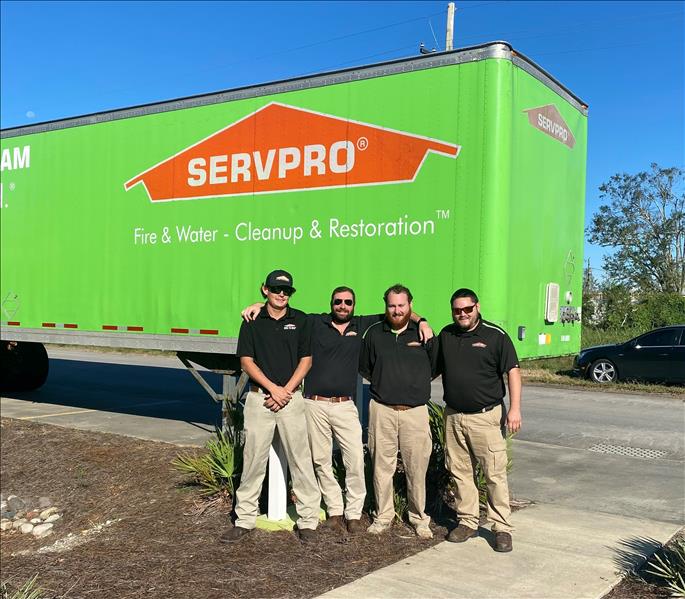 Our SERVPRO Disaster Recovery Team poses in front of a SERVPRO vehicle filled with equipment to combat the water damages after Hurricane Ida.
Our SERVPRO Disaster Recovery Team poses in front of a SERVPRO vehicle filled with equipment to combat the water damages after Hurricane Ida.
Hurricane season is almost in full swing. The National Oceanic and Atmospheric Administration is predicting an above-normal and active Atlantic hurricane season. NAOO is predicting around 13 to 20 storms that could reach winds up to 39 mph or higher. This information is crucial for our community to know and understand so we can come together to spread awareness and prepare our homes and businesses for potential damage.
How to Prepare according to ready.gov:
- Make an Emergency plan - make sure everyone in your household understands what to do in case of an emergency. Make sure your business has a SERVPRO Emergency Ready Plan or continuity plan in place.
- Know your evacuation zone - follow local emergency instructions and learn your evacuation routes
- Recognize warnings and alerts - download the FEMA app to received real-time alerts from the National Weather Service
- Review important documents - check on your insurance policies, and purchase flood insurance if you think your home is at risk for flooding. Gather personal documents.
- Strengthen your home - clean out your gutters, clear debris from roof, remove outdoor furniture and other items susceptible to heavy wind.
- Get tech ready - purchase generators, cell phone backup chargers and keep electronics power up before a storm
- Help your neighborhood - check on senior neighbors and others who may need help buying supplies
- Gather supplies - make sure you have a fully stocked emergency kit with water, medication, pet supplies, flashlights, etc.
Do You Have a Car Emergency Kit?
7/15/2021 (Permalink)
We talk about emergency preparedness for your home or business all the time, however what many people tend to overlook is having an emergency kit in your car. A lot of people spend many hours in their cars and it’s so important to always be prepared in case of an emergency, like a sudden storm or accident.
Here is a short list of items that are a must have in your car emergency kit:
- Jumper cables
- Spare tire, wheel wrench, tripod jack
- Multipurpose utility tool or tool kit
- Flashlights and batteries
- Reflective Triangle
- First-Aid Kit
- Non-Perishable Foods like nuts, dried food, candy
- Water
- Duct tape
- Rain Poncho
- For colder weather: snow brush, warm clothing, blanket
SERVPRO of Chesterfield and SERVPRO of Tri-Cities, Plus wants to make sure that you are prepared in case of a storm or emergency while on the road.
How to Prepare for Heavy Rains
7/6/2021 (Permalink)
The first tropical storm of the season is coming and her name is Elsa. No, Elsa is not a winter storm as the name would be most appropriately chosen for, however, this tropical storm will still bring some destruction such as heavy winds and rain.
Elsa is only expected to hit our area with some heavy rains, but our SERVPRO of Chesterfield and SERVPRO of Tri-Cities, Plus team wants you to prepare before the storm hits. Check out these quick tips below:
- Clean out your gutters - heavy rainfall can quickly build up in clogged gutters leaving the potential for water to intrude into your home
- Inspect Your roof, especially in older homes - fix any signs of damage, cracks or leaks
- Trim branches that could potentially cause damage to your house or property - heavy rains combined with some wind power can cause dead and dying branches and limbs to fall leaving a mess, or worse, a hole in your roof.
- Make an Emergency Kit - in case of power outages, make sure you have a container of flashlights, batteries, candles, water bottles, a first-aid kit, and other necessary items.
- Check your Insurance Policy - make sure you understand your coverage policy and also keep in mind, flood damage insurance needs to be purchased separately.
In the event of a water damage from a storm, call the professionals at SERVPRO of Chesterfield and SERVPRO of Tri-Cities, Plus at 804-378-2323.
Hurricane Season is Upon Us
6/9/2021 (Permalink)
Hurricane season has officially started and we want to make sure our community is well prepared for what to do in case a storm heads our way. Here are some tips to ensure you and your loved ones are safe during this upcoming storm season:
Know your Risk. Hurricanes are not just a coastal threat. Rain, wind, water, even tornadoes could happen far inland from where a hurricane or tropical storm makes landfall. https://www.weather.gov/wrn/2020-determine-your-risk
Make an Emergency Plan. When a storm is coming to your area, know how to stay in touch with your family and friends, and where you will go if your home becomes unsafe. Include places like your office, daycare, and anywhere you frequent when making your hurricane plan. Have a planned route and an alternate route to get to a safe place away from the storm. http://www.ready.gov/
Build an Emergency Kit. Keep an emergency kit stocked with non-perishable food items, water, blankets, essential documents, a battery backup to charge your cell phone, radio, toys, and supplies for your pets. Have enough supplies to last you at least 72 hours. https://www.ready.gov/kit
Stay Informed. Pay attention to weather forecasts in your area provided by local news outlets or weather apps on your phone. You can turn on Wireless Emergency Alerts on your phone to receive emergency alerts from the National Weather Service. If you live in a mandatory evacuation zone, listen to your local officials, and evacuate immediately if told to do so. https://www.weather.gov/
Remember to stay safe and use these tips to help you be more prepared during hurricane season this year. We are a proud partner with the Red Cross and take part in cleaning up damages after a storm. Our team is also an extreme team, meaning we have the tools and trained professionals who can travel across the country to assist with storm damage. SERVPRO of Chesterfield and SERVPRO of Tri-Cities, Plus will respond 24-hours a day to emergency fire and water services.
What To Do Before The Ice Storm Hits
2/17/2021 (Permalink)
What You Need Before the Ice Storm Hits
This past Saturday’s ice storm was one for the books. It was the biggest ice storm to his central Virginia is 20 years, causing massive power outages and hundreds of accidents on the roads. And now a new ice storm system is heading our way again tomorrow. If we’ve learned anything from Saturday, it’s that preparing for no power or heat is a must. Tree limbs can’t hold the weight of the ice and it’s inevitable for more to fall on the power lines, disrupting our comfort at home.
Check out this list of everything you need before the storm hits:
- Purchase a generator from your local hardware store
- Make sure you have enough candles, flashlights/lanterns and batteries
- Stock up on food and water
- If you have a wood burning fireplace, stock up on wood to keep warm
- Charge up your cell phones, laptops and other devices and purchase a portable cell phone charger
- Make sure you know where your main water shut off valves are located in case a pipe bursts
- Turn your refrigerator and freezer to the coldest setting
- Purchase some shake-activated hand warmers to keep you warm
During the storm, stay off the roads to avoid accidents. Make sure you have plenty of blankets and warm layers. It is also a good idea to stuff towels up again doorways to keep the heat inside and avoid leaks and drafts.
September is National Preparedness Month
8/19/2020 (Permalink)
September is almost here! It is recognized as National Preparedness Month to remind everyone that “we must all take action, now and throughout the year, for the types of emergencies that could affect us where we live, work, and also where we visit,” (ready.gov).
With the recent flooding in Louisiana in mind, the last thing you want to worry about is how to communicate and what to do during a disaster like this horrific event that killed hundreds and left many families without homes.
What you can do:
- Make A Family Plan – you may not be together with your family during a disaster.
- Set up emergency alerts from local officials
- Discuss family plans for disasters and plan where to go for safety.
- Collect information on paper including, phone numbers, emails, social media, medical facilities, doctors, service providers, school
- Decide on safe, familiar places where your family can go for protection and if you have pets think about animal-friendly locations
- Take Action – ensure you can go for at least 3 days without electricity, water service, access to supermarket, or other local services
- Prepare a disaster supply kit (water, food, battery-powered radio, flashlight, first aid kit, whistle, local maps)
- Bookmark weather.gov to stay informed on severe weather
- Learn about wireless emergency alerts, messages that will be sent to your phone during an emergency
Consider the following disasters that can occur at any time: Learn more about hazards which can affect your community and ways you can take action to prepare.
- Earthquakes – can occur suddenly and be deadly. Most earthquake-related casualties result from collapsing walls, flying glass, and falling objects.
- Floods - Flooding is the most common natural disaster in the United States and can happen anywhere.
- Hurricanes - have the power to cause widespread devastation, and can affect both coastal and inland areas.
- Tornadoes - are one of nature’s most violent storms, and can cause death, injury, and destruction within seconds.
- Wildfires - can occur anywhere and can destroy homes, businesses, infrastructure, natural resources, and agriculture.
Prevent Water Damage After Rain Storm
7/2/2020 (Permalink)
Everyone can enjoy the occasional summer thunderstorm - but it could cause major problems if rain water seeps into your home. One of the most common sources of water damage in a home is from rain water. It can enter through leaks in your roof, seeping in from the foundation, or even flooding into your basement. It is important to take the necessary steps to prevent water damage in your home such as:
Checking for proper drainage:
- inspect your roof thoroughly for structural damage or holes
- clear your gutters from leaves and other debris that could block the flow of water from draining into the yard
Install or Check Sump Pumps:
- sump pump are very effective for keeping rainwater out of your house
- have a professional check your sump pump to insure it is working properly once a year
Check sealant inside and outside foundation
- make sure the tar sealant covering the inner and outer sides of the foundation are intact
Inspect the slope of your lawn
- grading is the slope of your lawn and it should always slope away from your home to redirect the rainwater from flooding around the foundations
When you are dealing with storm, flood, and water damage, immediate action is crucial. You should choose the company with storm damage experience and expertise that has the resources and equipment to handle the job. SERVPRO of Chesterfield and SERVPRO of Tri-Cities Plus can respond immediately to storm and flooding conditions.
Tornado Season
6/26/2020 (Permalink)
Luckily, in the Chesterfield, VA we do not experience the potential threats that tornadoes can have as often as other parts of the country. These places include the upper Mid-west, the northern and southern plains and the Gulf coast.
Tornado season usually refers to the time of year the U.S. sees the most tornadoes. The peak “tornado season” for the Southern Plains is during May into early June. On the Gulf coast, it is earlier during the spring. In the northern plains and upper Midwest, tornado season is in June or July. But, remember, tornadoes can happen at any time of year. Tornadoes can also happen at any time of day or night, but most tornadoes occur between 4–9 p.m.
However, it is always a good idea to be prepared in case a disaster strikes. About 1,200 tornadoes hit the U.S. yearly. Since official tornado records only date back to 1950, we do not know the actual average number of tornadoes that occur each year. Plus, tornado spotting and reporting methods have changed a lot over the last several decades.
SERVPRO of Chesterfield and SERVPRO of Tri-Cities Plus will respond 24-hours a day to emergency fire and water services. We are a proud partner with the Red Cross and take part in cleaning up damages after a storm. Our team is also an extreme team, meaning we can travel across the country to assist with a storm damage or very large loss. We have the tools and the people who have experience in water, storm, fire damage restoration and we are always here to help.
Are You Thunderstorm Prepared?
6/22/2020 (Permalink)
According to the Red Cross:
"A thunderstorm is considered severe if it produces hail at least 1 inch in diameter or has wind gusts of at least 58 miles per hour. Every thunderstorm produces lightning, which kills more people each year than tornadoes or hurricanes. Heavy rain from thunderstorms can cause flash flooding, and high winds can damage homes and blow down trees and utility poles, causing widespread power outages."
At SERVPRO of Chesterfield and SERVPRO of Tri-Cities Plus, we want you to understand the potential dangers a thunderstorm can have on your safety and property.
How to Prepare for Thunderstorms
- Learn about your local community’s emergency warning system for severe thunderstorms
- Discuss thunderstorm safety and lightning safety with all members of your household
- Pick a safe place in your home for household members to gather during a thunderstorm This should be away from windows, skylights and glass doors that could be broken by strong winds or hail
- Make a list of items to bring inside in the event of a severe thunderstorm
- Make trees and shrubbery more wind resistant by keeping them trimmed and removing damaged branches
- Protect your animals by ensuring that any outside buildings that house them are protected in the same way as your home
- Consult your local fire department if you are considering installing lightning rods
If your home or business is affected after a storm, call the professionals at SERVPRO of Chesterfield and SERVPRO of Tri-Cities Plus to make it "Like it never even happened."
The Impact of Summer Storms
6/11/2020 (Permalink)
There is always potential for flooding after a thunderstorm dumps a large amount of rain in a short amount of time. Thunderstorms are most common during the summer due to the surplus of moisture in the air as well as rising warm air. These two factors combined together create the potential for increased damage caused by the storm. With their prevalence throughout the summer season, it is important to understand the threats to homes and businesses posed by the lightning and flash flooding brought on by thunderstorms.
Damage Caused by Flooding
When a flood strikes your home or business, water levels can rise quickly and inflict a significant amount of damage. The flood water can carry mud and sediment, therefore contaminating the water and whatever it touches in your home or business. From this water damage, mold can grow and spread if the affected area is not remediated quickly. Flood water commonly affects drywall, flooring, and electrical systems such as cooling and heating systems, so it will be crucial to assess these areas for damage after a flood. On a larger scale, flood water can move houses or buildings off of their foundation, so be sure to watch for signs of that as well.
Damage Caused by Lightning
Lightning can cause both physical and electrical damage to homes and businesses if the building is directly hit by lightning during a thunderstorm. Lightning can burn through roofs, rip shingles or gutters from the building, and even tear into attics. In terms of electrical damage, lightning can increase the risk of an electrical fire igniting. Electronic appliances inside of your home, such as computers and refrigerators, can be harmed or destroyed if left plugged into an outlet during a thunderstorm.
What to Do After the Storm
Immediately following the storm, survey your home or building for any visible indicators of lightning or water damage. This includes making sure that electrical breakers, outlets, and light switches are still functioning, checking plumbing systems for any leakage, and looking for any visible signs of water damage to items within the house or building. While cleaning up any damage, be sure to turn off all water and electrical systems so that when the electricity is restored, the water and electricity do not react with one another, which would result in further damage.
If your home or business has been affected with damage after a thunderstorm, call SERVPRO of Chesterfield and SERVPRO of Tri-Cities Plus to professionally handle the damages at 804-378-2323.
Are You Hurricane Prepared?
5/8/2020 (Permalink)
Is Your Home Hurricane Ready?
If you plan to ride out a hurricane in your home, make sure it is in good repair and up to local hurricane building code specifications. Have the proper plywood, steel or aluminum panels to board up the windows and doors. Remember, the garage door is the most vulnerable part of the home, so it must be able to withstand high winds.
Who's Around You?
Many Americans rely on their neighbors after a disaster, but there are also many ways you can help your neighbors before a hurricane approaches. Learn about all the different actions you and your neighbors can take to prepare and recover from the hazards associated with hurricanes. Start the conversation now with these Neighbor Helping Neighbor strategies but remember you may need to adjust your preparedness plans based on the latest health and safety guidelines from the CDC and your local officials.
Be Flood Smart
4/17/2020 (Permalink)
Floods are one of the most common and widespread natural disasters in the United States. Whether your home or business is near a coastline, along city streets, in the mountains, or near a river there is always the potential for flood damage. Floodsmart.gov reports, in the last five years, all 50 states have experienced floods or flash floods.
Just 1 inch of water can cause $25,000 of damage to your home.
According to the American Red Cross (ARC), floods cause more damage in the U.S. every year that any other weather-related disaster. The ARC offers the following flood safety tips:
- Stay away from floodwaters. If you come up on a flowing stream where water is above your ankles, stop, turn around and go another way. Six inches of swiftly moving water can sweet you off of your feet.
- If you approach a flooded road while driving, turn around and go another way. If you are caught on a flooded road and waters are rising rapidly around you, get out of the car and quickly move to higher ground. Most cars can be swept away by less than two feet of moving water.
- Keep children out of the water. They are curious and often lack judgment about running water or contaminated water.
If a flood does strike your home or business, contact the SERVPRO of Chesterfield and SERVPRO of Tri-Cities Plus at (804)-378-2323.
Even minor floods have the potential to cause major damage to a structure when not treated quickly and properly, and the cleanup is often an overwhelming task. The SERVPRO team is prepared to handle any size disaster.
Thunderstorm Safety and Preparedness
6/24/2019 (Permalink)
According to the Red Cross, A thunderstorm is considered severe if it produces wind gusts of at least 58 miles per hour. Every thunderstorm produces lightning, which kills more people each year than tornadoes or hurricanes. Heavy rain from thunderstorms can cause flash flooding, and high winds can damage homes and blow down tree and utility poles - causing widespread power outages.
WATCH vs. WARNING
Watch: Severe thunderstorms are possible in and near the watch area
Warning: Severe weather has been reported by spotters or indicated by radar. Warnings indicate imminent danger to life and property.
Be Prepared
- Learn about your local community’s emergency warning system for severe thunderstorms
- Pick a safe place in your home for household members to gather during a thunderstorm This should be away from windows, skylights and glass doors that could be broken by strong winds or hail
- Make a list of items to bring inside in the event of a severe thunderstorm
- Make trees and shrubbery more wind resistant by keeping them trimmed and removing damaged branches
- Protect your animals by ensuring that any outside buildings that house them are protected in the same way as your home
Make Preparedness Kit
- Water—one gallon per person, per day
- Food—non-perishable, easy-to-prepare
- Flashlight
- Battery-powered or hand-crank radio (NOAA Weather Radio, if possible)
- Extra batteries
- First aid kit
- Medications (7-day supply) and medical items
- Multi-purpose tool
- Sanitation & personal hygiene items
- Copies of personal documents
- Cell phone with chargers
- Family & emergency contact information
- Extra cash
Final Step
Call SERVPRO of Chesterfield and SERVPRO of Tri-Cities Plus at 804.378.2323 if your home or business experiences damages from a storm. We have the resources to handle any size disaster.
Is Your Home Ready for the Storm?
6/17/2019 (Permalink)
This time of the year is known for surprising thunderstorms that can appear quickly and sometimes, without us being aware. That's why it's important to prepare your home and take the necessary precautions before heavy rains or winds damage your property.
Follow These Suggested Tips:
- Check gutters - make sure your downspouts drain away from the home's foundation and clear the gutters for debris blockage
- Clear limb and trim trees - loose limbs can puncture your home's exterior
- Secure furniture - patio furniture and other large items in your yard are at risk of flying away and damaging your home's exterior
- Stock a basic emergency kit - water, food, battery radio, flashlight, first-aid kit
If your home experiences a water damage after a storm hits, don't hesitate to call SERVPRO of Chesterfield and SERVPRO of Tri-Cities Plus at 804.378.2323.
Never too Early to Be Prepared
6/13/2019 (Permalink)
Before Winter Storms and Extreme Cold
To prepare for a winter storm you should do the following:
Before winter approaches, add the following supplies to your emergency kit:
- Rock salt or more environmentally safe products to melt ice on walkways. Visit the Environmental Protection Agency for a complete list of recommended products.
- Sand to improve traction.
- Snow shovels and other snow removal equipment.
- Sufficient heating fuel. You may become isolated in your home and regular fuel sources may be cut off. Store a good supply of dry, seasoned wood for your fireplace or wood-burning stove.
- Adequate clothing and blankets to keep you warm.
- Make a Family Communications Plan. Your family may not be together when disaster strikes, so it is important to know how you will contact one another, how you will get back together and what you will do in case of an emergency.
- A NOAA Weather Radio broadcasts alerts and warnings directly from the NWS for all hazards. You may also sign up in advance to receive notifications from your local emergency services.
Download FEMA’s Be Smart. Know Your Alerts and Warnings for a summary of notifications at:www.ready.gov/prepare. Free smart phone apps, such as those available from FEMA and the American Red Cross, provide information about finding shelters, providing first aid, and seeking assistance for recovery.
- Minimize travel. If travel is necessary, keep a disaster supplies kit in your vehicle.
- Bring pets/companion animals inside during winter weather. Move other animals or livestock to sheltered areas with non-frozen drinking water.
Never Too Early to Prepare for Nasty Winter Weather
6/12/2018 (Permalink)
Before Winter Storms and Extreme Cold
To prepare for a winter storm you should do the following:
Before winter approaches, add the following supplies to your emergency kit:
- Rock salt or more environmentally safe products to melt ice on walkways. Visit the Environmental Protection Agency for a complete list of recommended products.
- Sand to improve traction.
- Snow shovels and other snow removal equipment.
- Sufficient heating fuel. You may become isolated in your home and regular fuel sources may be cut off. Store a good supply of dry, seasoned wood for your fireplace or wood-burning stove.
- Adequate clothing and blankets to keep you warm.
- Make a Family Communications Plan. Your family may not be together when disaster strikes, so it is important to know how you will contact one another, how you will get back together and what you will do in case of an emergency.
- A NOAA Weather Radio broadcasts alerts and warnings directly from the NWS for all hazards. You may also sign up in advance to receive notifications from your local emergency services.
Download FEMA’s Be Smart. Know Your Alerts and Warnings for a summary of notifications at:www.ready.gov/prepare. Free smart phone apps, such as those available from FEMA and the American Red Cross, provide information about finding shelters, providing first aid, and seeking assistance for recovery.
- Minimize travel. If travel is necessary, keep a disaster supplies kit in your vehicle.
- Bring pets/companion animals inside during winter weather. Move other animals or livestock to sheltered areas with non-frozen drinking water.
Prepare Your Home
6/12/2018 (Permalink)
Tips for Preparing your Home for Winter Weather
- Keep cabinet doors open during cold spells. This allows warm air to circulate around pipes.
- Keep a slow trickle of water flowing through faucets, especially if the pipes for faucets run through unheated or non-insulated areas of your home.
- Consider shutting off outdoor faucets. Find the shut-off valve in the basement or crawl space and turn it to "off."
- If you follow the previous step, then open the outdoor faucet to help ensure it drains completely and the inner valve is shut off.
- Ensure gutters are clean and secure. Leaves and debris accumulate, causing a damming effect on gutters, which could lead to roof problems and water damage.
- Proper maintenance of your furnace can help reduce the risk of puffbacks.






 24/7 Emergency Service
24/7 Emergency Service
